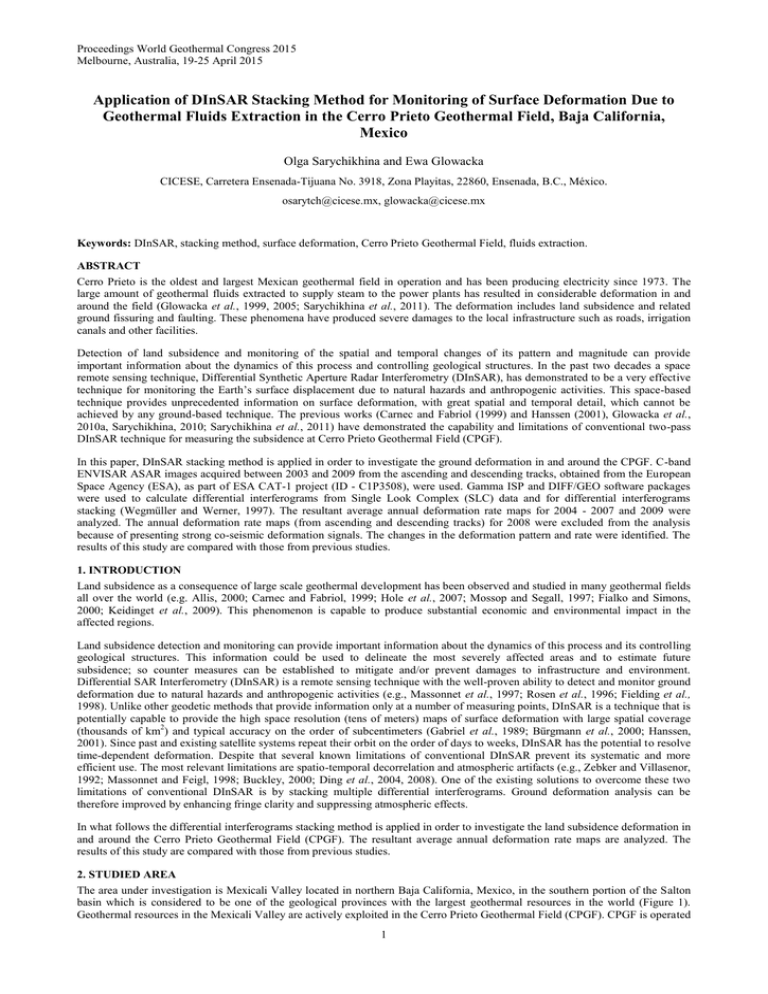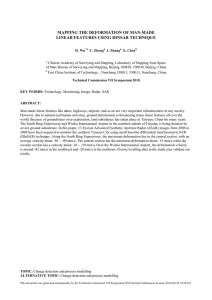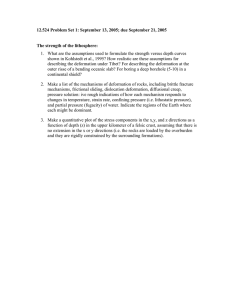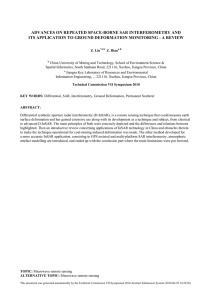Application of DInSAR Stacking Method for Monitoring of Surface
advertisement

Proceedings World Geothermal Congress 2015 Melbourne, Australia, 19-25 April 2015 Application of DInSAR Stacking Method for Monitoring of Surface Deformation Due to Geothermal Fluids Extraction in the Cerro Prieto Geothermal Field, Baja California, Mexico Olga Sarychikhina and Ewa Glowacka CICESE, Carretera Ensenada-Tijuana No. 3918, Zona Playitas, 22860, Ensenada, B.C., México. osarytch@cicese.mx, glowacka@cicese.mx Keywords: DInSAR, stacking method, surface deformation, Cerro Prieto Geothermal Field, fluids extraction. ABSTRACT Cerro Prieto is the oldest and largest Mexican geothermal field in operation and has been producing electricity since 1973. The large amount of geothermal fluids extracted to supply steam to the power plants has resulted in considerable deformation in and around the field (Glowacka et al., 1999, 2005; Sarychikhina et al., 2011). The deformation includes land subsidence and related ground fissuring and faulting. These phenomena have produced severe damages to the local infrastructure such as roads, irrigation canals and other facilities. Detection of land subsidence and monitoring of the spatial and temporal changes of its pattern and magnitude can provide important information about the dynamics of this process and controlling geological structures. In the past two decades a space remote sensing technique, Differential Synthetic Aperture Radar Interferometry (DInSAR), has demonstrated to be a very effective technique for monitoring the Earth’s surface displacement due to natural hazards and anthropogenic activities. This space-based technique provides unprecedented information on surface deformation, with great spatial and temporal detail, which cannot be achieved by any ground-based technique. The previous works (Carnec and Fabriol (1999) and Hanssen (2001), Glowacka et al., 2010a, Sarychikhina, 2010; Sarychikhina et al., 2011) have demonstrated the capability and limitations of conventional two-pass DInSAR technique for measuring the subsidence at Cerro Prieto Geothermal Field (CPGF). In this paper, DInSAR stacking method is applied in order to investigate the ground deformation in and around the CPGF. C-band ENVISAR ASAR images acquired between 2003 and 2009 from the ascending and descending tracks, obtained from the European Space Agency (ESA), as part of ESA CAT-1 project (ID - C1P3508), were used. Gamma ISP and DIFF/GEO software packages were used to calculate differential interferograms from Single Look Complex (SLC) data and for differential interferograms stacking (Wegmüller and Werner, 1997). The resultant average annual deformation rate maps for 2004 - 2007 and 2009 were analyzed. The annual deformation rate maps (from ascending and descending tracks) for 2008 were excluded from the analysis because of presenting strong co-seismic deformation signals. The changes in the deformation pattern and rate were identified. The results of this study are compared with those from previous studies. 1. INTRODUCTION Land subsidence as a consequence of large scale geothermal development has been observed and studied in many geothermal fields all over the world (e.g. Allis, 2000; Carnec and Fabriol, 1999; Hole et al., 2007; Mossop and Segall, 1997; Fialko and Simons, 2000; Keidinget et al., 2009). This phenomenon is capable to produce substantial economic and environmental impact in the affected regions. Land subsidence detection and monitoring can provide important information about the dynamics of this process and its controlling geological structures. This information could be used to delineate the most severely affected areas and to estimate future subsidence; so counter measures can be established to mitigate and/or prevent damages to infrastructure and environment. Differential SAR Interferometry (DInSAR) is a remote sensing technique with the well-proven ability to detect and monitor ground deformation due to natural hazards and anthropogenic activities (e.g., Massonnet et al., 1997; Rosen et al., 1996; Fielding et al., 1998). Unlike other geodetic methods that provide information only at a number of measuring points, DInSAR is a technique that is potentially capable to provide the high space resolution (tens of meters) maps of surface deformation with large spatial coverage (thousands of km2) and typical accuracy on the order of subcentimeters (Gabriel et al., 1989; Bürgmann et al., 2000; Hanssen, 2001). Since past and existing satellite systems repeat their orbit on the order of days to weeks, DInSAR has the potential to resolve time-dependent deformation. Despite that several known limitations of conventional DInSAR prevent its systematic and more efficient use. The most relevant limitations are spatio-temporal decorrelation and atmospheric artifacts (e.g., Zebker and Villasenor, 1992; Massonnet and Feigl, 1998; Buckley, 2000; Ding et al., 2004, 2008). One of the existing solutions to overcome these two limitations of conventional DInSAR is by stacking multiple differential interferograms. Ground deformation analysis can be therefore improved by enhancing fringe clarity and suppressing atmospheric effects. In what follows the differential interferograms stacking method is applied in order to investigate the land subsidence deformation in and around the Cerro Prieto Geothermal Field (CPGF). The resultant average annual deformation rate maps are analyzed. The results of this study are compared with those from previous studies. 2. STUDIED AREA The area under investigation is Mexicali Valley located in northern Baja California, Mexico, in the southern portion of the Salton basin which is considered to be one of the geological provinces with the largest geothermal resources in the world (Figure 1). Geothermal resources in the Mexicali Valley are actively exploited in the Cerro Prieto Geothermal Field (CPGF). CPGF is operated 1 Sarychikhina and Glowacka by the Mexican Federal Electricity Commission (Comisión Federal de Electricidad, CFE) and has been producing electricity since 1973. Cerro Prieto is the oldest and largest Mexican geothermal field in operation and is the second largest in the world with energy output of 720 MW. Cerro Prieto is a high-temperature (250-350 C), fluid-dominated field, contained in sedimentary rocks. LATITUDE (degrees) Mexicali Valley is part of the Salton Trough tectonic province, which lies on the Pacific–North American plate boundary (Figure 1). This zone is characterized by high tectonic seismicity, heat flow and ground deformation, related to the tectonic regime of the zone. Besides the tectonic deformation, the large amount of geothermal fluids extracted to supply steam to the power plants produces considerable deformation in and around the field (Glowacka et al., 1999, 2005, 2010a, b; Sarychikhina et al., 2011). The deformation includes land subsidence and related ground fissuring and faulting. These phenomena have produced severe damages to the local infrastructure such as roads, irrigation canals and other facilities. The detailed plan of the study is presented in Figure 2. LONGITUDE (degrees) Figure 1: Regional map of northern Baja California, Mexico, and southern California, USA. The Shuttle Radar Topography Mission Digital Elevation Model is used as background. Large white rectangles indicate the spatial coverage of ENVISAT ASAR images. D indicates descending track, and A indicates ascending track. White arrows indicate the radar view direction for each track. The smaller white rectangle represents the study area. The small yellow filled rectangle indicates the Cerro Prieto Geothermal Field site. The principal tectonic faults and structures are also indicated: ABF = Agua Blanca Fault, BB = Brawley Basin, CDD = Cañada David Detachment, CPB = Cerro Prieto Basin, CPF = Cerro Prieto Fault, EF = Elsinore Fault, IF = Imperial Fault, LSF = Laguna Salada Fault, SJF = Sierra Juarez Fault, SJFZ = San Jacinto Fault Zone, SMF = San Miguel Fault. Modified from Suárez-Vidal et al., (2008). X (m) - UTM IF Y (m) - UTM F M 20000 CPV 00 1 00 A’ GF SF 0 CP A F SF’ Figure 2: Plan of the study area. The black thick dotted line frames the limits of the Cerro Prieto Geothermal Field. The borders of the evaporation pond and the Cerro Prieto volcano (CPV) are also shown (thin gray lines). A striped orange rectangle indicates the extraction area of CPIV which started the operation since 2000. Solid red lines are well-known surface traces of tectonic faults. CPF=Cerro Prieto Fault, GF=Guerrero Fault, IF=Imperial Fault, MF=Morelia Fault, SF=Saltillo fault. Dotted red lines are proposed surface fault traces based on mapped fissure zones from González et al. (1998), Glowacka et al. (2006, 2010a), Lira (2006) and Suárez-Vidal et al. (2007, 2008). SF’ is continuation of Saltillo fault as proposed by Suárez-Vidal et al. (2008). Black thick line correspond to the profile A-A' illustrated in Figure 4. Marks with labels are shown every 10000 m of distance along the profile A-A’. Black square marks the location of reference region, supposed to be. Modified from Glowacka et al. (2010a). 2 Sarychikhina and Glowacka The subsidence history at the CPGF area has been well documented. Geodetic studies in the Mexicali Valley began in the 1960s. Ground deformation in the studied area has been monitored by repeat ground survey with precise leveling and GPS, and is currently monitored by quasi continuous records of geotechnical instrument network (tiltmeters and extensometers). Analysis of leveling data and CPGF extraction history (Glowacka et al., 1999), and modeling of the tectonic and anthropogenic components of ground subsidence (Glowacka et al., 2005) suggested that the current deformation rate is mainly related to the fluid extraction. The high deformation rate and spatial correlation between locations of the ground deformation maximum and extraction wells zone was confirmed by DInSAR method (Carnec and Fabriol, 1999; Hanssen, 2001). However the field observation (Gonzalez et al., 1998; Glowacka et al., 1999, 2010a, b; Suárez-Vidal et al., 2008) and geotechnical instruments data (Glowacka et al., 1999, 2008, 2010a, b) reveal that the geometry of the subsiding area is controlled by tectonic faults. 3. DATA AND PROCESSING DInSAR technique is based on the combination of two Synthetic Aperture Radar (SAR) images acquired for the same area at different times from slightly different positions. The result of this combination is a new image known as interferogram, whose main phase component, after corrections for topography and earth curvature, is the ground displacement along the radar Line of Sight (LOS). For an introduction to the DInSAR method, see Gabriel et al. (1989), Massonnet and Rabaute (1993), Gens and van Genderen (1996), Massonnet and Feigl (1998), Rosen et al. (2000) and Hanssen (2001). Previous DInSAR studies of ground deformation in the Mexicali Valley showed that the vegetation cover of a great part of this area makes the application of the conventional DInSAR technique very challenging (Carnec and Fabriol, 1999; Hanssen, 2001, Sarychikhina, 2010; Sarychikhina et al., 2011). The temporal decorrelation in the areas covered by agricultural fields around the CPGF increases considerably for interferometric pairs that span more than three months, and makes the DInSAR phase of long time period interferograms difficult to measure and unwrap. On the other hand, the accuracy of the displacement estimates from individual, short time spanning, differential interferograms is limited by the atmospheric path delay. Here, the stacking method, which consisted in averaging of multiple differential interferograms in order to overcome these two shortcomings of conventional DInSAR, has been carried out. C-band ENVISAT ASAR images from descending and ascending tracks covering the period from 2003 to 2009 were used in this study. Figure 1 illustrates the outline SAR frames from satellites used in this study. Data processing has been performed using the Gamma commercial software, developed by Wegmüller and Werner (1997) by first performing two pass – interferometry and unwrapping of differential interferograms and then realizing the multiple interferograms stacking and geocoding. The selection of interferograms for stacking was based in their quality in terms of high coherence and low noise level. Since it was pretended to analyze the deformation of only aseismic character in this study, the interferometric pairs presenting deformation signal from moderate sized earthquakes were not included to the stacking. It was impossible to generate aseismic LOS displacement rate map for 2008 due to high level of moderate sized seismicity in this year. 4. DEFORMATION RATE MAPS ANALYSIS Figure 3 illustrates the maps of annual LOS displacement rate for 2004 – 2007 and 2009 periods obtained using differential interferograms stacking method. The results from both tracks, ascending and descending, are presented. Only for 2007 it was possible to obtain map of LOS displacement rate for both tracks, due to availability of the images. The similarity between maps of LOS displacement rate from ascending and descending tracks, along with the known vertical displacement from ground-based measurements including leveling surveys, suggest that the observed LOS displacements may be interpreted as reflecting mostly vertical surface displacement. The negative values in the Figure 3 indicate an increase in the LOS range what corresponds to the ground subsidence. All maps of LOS displacement rate show a roughly NE–SW oriented elliptical-shaped pattern of deformation with two bowls exhibiting high subsidence rates. The subsiding area boundaries appear to correlate with faults, as can be seen in Figure 3 where they are superimposed onto the maps of LOS displacement rate. The first region of subsidence, with larger LOS displacement rate for all analyzed periods (Figure 3), is located in the area between the eastern limits of the CPGF and the Saltillo fault, which was proposed as recharge zone in previous studies (Glowacka et al., 1999, 2005; Sarychikhina, 2003). The maximum LOS displacement rate in this region increased from 12 cm/yr in 2004 to 16-17 cm/yr in 2007 and 2009. This value of maximum LOS displacement rate corresponds to ~18 cm/yr of ground subsidence. The second region of subsidence is located in the CPGF production zone. The maximum LOS displacement rate in this region is located in the central part of the field in 2004, while in 2005-2007 and 2009 it is located in eastern part of the field, zone where the production started in 2000 (see Figure 2). The maximum LOS displacement rate in the CPGF production zone is ~9 cm/ yr in 2004 and ~10-11 cm/yr in 2005-2007and 2009. Figure 4 shows the profile across the subsidence zone with the annual LOS displacement rates obtained using stacking method. The changes in the spatial pattern and rate of LOS displacement could be appreciated in this figure. The important difference between LOS displacement rates obtained from ascending and descending tracks could be observed in the central part of the CPGF (100002500 m in the A-A’ profile). This indicates the influence of horizontal displacement component, probably related to the horizontal displacement in the border of subsidence bowl, as proposed by Segall (1989). 5. DISCUSSION A comparison of the annual aseismic LOS displacement rates for 2004-2007 and 2009 obtained using multiple differential interferograms stacking method reveals the important changes in spatial pattern and rate of the deformation in the study area. The main changes in the analyzed period occurred between 2004 and 2005, and include the increase of deformation rate in the recharge zone and the migration of maximum of deformation in the CPGF production zone to the northeast. Since 2005, the spatial pattern and rate of deformation could be considerate constant (or without important changes). The similar changes in space pattern and rate of deformation were found before comparing leveling results of 1994-1997 and 1997–2006 (Sarychikhina et al., 2011). Glowacka et al.( 2010a, b) analyzed the record of vertical extensometer installed in Saltillo fault, eastern border of subsiding area, and found the creep rate change from 5.3 (for 1996 - 2003) to 7.3 cm/year (2003 – 2009). The authors of mentioned studies stated that the observed changes in the ground deformation pattern and Saltillo fault slip rate may be caused by production development in the CPGF due to the newest power plant (CP IV), which started operating in 2000 in the eastern part of field and decrease of production in the western part of CPGF (CP I). Since 2000 there was not considerable changes in the CPGF production, so based on 3 Sarychikhina and Glowacka the results of this study, we can state that it took ~5 years the subsidence to stabilize after the perturbation caused by changes in the CPGF production. 6. ACKNOWLEDGMENTS Data from the European Space Agency's ENVISAT satellite was used to generate the interferometric data. The data were obtained as part of ESA Cat-1 Project (ID — C1P3508). This research was sponsored in part by CONACYT, project 105907 and CICESE internal funds. Figure 3: Maps of LOS displacement rate (cm/yr) showing the time evolution of the ground deformation field in and around the Cerro Prieto Geothermal Field in Mexicali Valley, Mexico. Maps were obtained using the multiple differential interferograms stacking method. The numbers in the right lower corner indicate the number of differential interferograms used in stack. Negative values indicate an increase in the LOS range (ground subsidence). Black square marks the location of the reference region. Tectonic faults (solid and dotted red lines), CPGF limits (black thick dotted line), evaporation pond and CPV (thin gray lines) are superimposed onto the maps. The maps are in UTM coordinates, the marks are every 5 km. 4 Sarychikhina and Glowacka Figure 4: Comparison between LOS displacement rates derived from multiple differential interferograms stacking method for different periods along the profile A-A’ which location is shown in Figure 2. Negative values indicate an increase in the LOS range (ground subsidence). Solid red lines indicate location of tectonic faults which crosses the profile AA’. Faults notation as in Figure 2. REFERENCES Allis, R.G.: Review of subsidence at Wairakei field, New Zealand, Geothermics, 29, (2000), 455–478. Buckley, S.M.: Radar interferometry measurement of urban land subsidence, Ph. D. dissertation, University of Texas at Austin, USA (2000). Bürgmann, R., Rosen, P.A. and Fielding, E.J.: Synthetic aperture radar interferometry to measure Earth’s surface topography and its deformation, Annual Review of Earth and Planetary Sciences, 28, (2000), 169–209. Carnec, C., and Fabriol, H.: Monitoring and modelling land subsidence at Cerro Prieto geothermal field, Baja California, Mexico, using SAR interferometry, Geophysical Research Letters, 26, (1999), 1211-1214. Ding, X.L., Liu, G.X., Li, Z.W., Li, Z.L., and Chen, Y.Q.: Ground subsidence monitoring in Hong Kong with satellite SAR interferometry, Photogrammetric Engineering and Remote Sensing, 70 (10), (2004), 1151–1156. Ding, X.L., Li, Z.W., Zhu, J.J., Feng, G.C., and Long, J.P.: Atmospheric effects on InSAR measurements and their mitigation, Sensors, 8, (2008), 5426–5448. Fialko, Y., and Simons, M.: Deformation and seismicity in the Coso geothermal area, Inyo County, California: Observations and modeling using satellite radar interferometry, Journal of Geophysical Research, 105 (B9), 21, (2000), 781–21,794. Fielding, E.J., Blom, R.G., and Goldstein, R.M.: Rapid subsidence over oil fields measured by SAR interferometry, Geophysical Research Letters, 27, (1998), 3215–3218 Gabriel, A. G., Goldstein, R. M., and Zebker, H. A.: Mapping small elevation changes over large areas: Differential radar interferometry, Journal of Geophysical Research, 94, (1989), 9183-9191. Gens, R., and Van Genderen, J.L.: SAR interferometry: Issues, techniques, applications, International Journal of Remote Sensing, 17 (10), (1996), 1803-1836. Glowacka E., Gonzalez, J., and Fabriol, H.: Recent Vertical deformation in Mexicali Valley and its Relationship with Tectonics, Seismicity and Fluid Operation in the Cerro Prieto Geothermal Field, Pure and Applied Geophysics, 156, (1999), 591-614. Glowacka, E., Sarychikhina, O., and Nava, A.F.: Subsidence and stress change in the Cerro Prieto Geothermal Field, B.C., Mexico, Pure and Applied Geophysics, 162, (2005), 2095–2110. Glowacka, E., Sarychikhina, O., Suárez, F., Mendoza, R., and Nava, F.A.: Estudio geológico para definir la zona de hundimiento con el fin de relocalización del canal Nuevo Delta en el Valle de Mexicali, Informe Técnico, CICESE, México (2006). 5 Sarychikhina and Glowacka Glowacka, E., Sarychikhina, O., Vázquez González, R., Nava, F.A., Munguía, L., Farfan, F., Diaz De Cossio, G., and Garcia Arthur, M.A.: Slow aseismic slip in the pull-apart center of Cerro Prieto (Baja California, Mexico), from geotechnical instruments and InSAR observations, Proceedings, SSA 2008 Annual Meeting, Seismological Society of America, Santa Fe, New Mexico, USA (2008). Glowacka, E., Sarychikhina, O., Suárez, F., Nava F. A., and Mellors: Anthropogenic subsidence in the Mexicali Valley, Baja California, Mexico, and slip on the Saltillo fault, Environmental Earth Sciences, 59 (7), (2010a) 1515-1524. Glowacka, E., Sarychikhina, O., Suárez, F., Nava, F. A, Farfan, F., De Cossio Batani, G. D., and Garcia Arthur, M. A.: Anthropogenic subsidence in the Mexicali Valley, B.C., Mexico, caused by the fluid extraction in the Cerro Prieto geothermal Field and the role of faults, Proceedings, World Geothermal Congress (WGC), Bali, Indonesia (2010b). González, J., Glowacka, E., Suárez, F., Quiñones, J.G., Guzmán, M., Castro, J.M., Rivera, F., and Félix, M.G.: Movimiento reciente de la Falla Imperial, Mexicali, B. C, Ciencia para todos Divulgare, UABC, 6 (22), (1998), 4-15. Hanssen, R.F.: Radar Interferometry: Data Interpretation and Error Analysis. Kluwer Academic Publishers, Dordrecht, The Netherlands (2001). Hole, J.K., Bromley, C.J., Stevens, N.F., and Wadge, G.: Subsidence in the geothermal fields of the Taupo Volcanic Zone, New Zealand from 1996 to 2005 measured by InSAR, Journal of Volcanology and Geothermal Research, 166, (2007), 125–146. Keiding, M., Hooper, A., Árnadóttir, T., Jónsson, S., and Decriem, J.: Natural and man-made deformation around geothermal fields on the Reykjanes peninsula, SW Iceland, Proceedings, Fringe 2009 Workshop, Frascati, Italy (2009). Lira, H.: Características del sismo del 23 de Mayo de 2006, Informe RE-023/2006, Comisión Federal de Electricidad, Residencia de Estudios, México (2006). Massonnet, D., and Rabaute, T.: Radar interferometry: limits and potential, IEEE Transactions on Geoscience and Remote Sensing, 31 (2), (1993), 455-464 Massonnet, D., Holzer, T., and Vadon, H.: Land subsidence by the East Mesa Geothermal Field, California, observed using Sar interferometry, Geophysical Research Letters, 22, (1997), 1537 – 1540. Massonnet, D., and Feigl, K.L.: Radar interferometry and its application to changes in the Earth’s surface, Reviews of Geophysics, 36 (4), (1998), 441-500. Mossop, A., and Segall, P.: Subsidence at the Geysers geothermal field, N. California from a comparison of GPS and leveling surveys, Geophysical Research Letters, 24 (14), (1997), 1839–1842. Rosen, P.A., Hensley, S., Zebker, H., Webb, F.H., and Fielding, E.J.: Surface deformation and coherence measurements of Kilauea Volcano, Hawaii, from SIR-C radar interferometry, Journal of Geophysical Research, 101, (1996), 23109–23125. Rosen, P. A., Hensley, S., Joughin, I.R., Li, F.K., Madsen, S.N., Rodriguez, E., and Goldstein, R.M.: Synthetic aperture radar interferometry, Proceedings of the IEEE, 88, (2000), 333-382. Sarychikhina, O.: Modelación de subsidencia en el campo geotérmico Cerro Prieto, M. Sc. Thesis, CICESE, Mexico (2003). Sarychikhina, O.: The spatial and temporal distribution of the ground deformations in the Mexicali Valley in the context of tectonic, anthropogenic and seismic processes, Ph. D. Thesis, CICESE, Mexico (2010). Sarychikhina, O., Glowacka, E., Mellors, R., and Suárez-Vidal, F.: Land subsidence in the Cerro Prieto Geothermal Field, Baja California, Mexico, from 1994 to 2005. An integrated analysis of DInSAR, leveling and geological data, Journal of Volcanology and Geothermal Research, 204, (2011), 76-90. Segall, P.: Earthquakes Triggered by Fluid Extraction, Geology, 17, (1989), 942–946. Suárez-Vidal, F., Munguía-Orozco, L., González-Escobar, M., González-García, J., and Glowacka, E.: Surface rupture of the Morelia fault near the Cerro Prieto Geothermal Field, Mexicali, Baja California, Mexico, during the Mw 5.4 earthquake of 24 May 2006, Seismological Research Letters, 78 (3), (2007), 394-399. Suárez-Vidal, F., Mendoza-Borunda, R., Nafarrete-Zamarripa, L., Rámirez, J., and Glowacka, E.: Shape and dimensions of the Cerro Prieto pull-apart basin, Mexicali, Baja California, México, based on the regional seismic record and surface structures, International Geology Review, 50 (7), (2008), 636-649. Wegmüller, U., and Werner C. L.: Gamma SAR processor and interferometry software, Proceedings, 3rd ERS Symposium, Florence, Italy (1997). Zebker, H., and J. Villasenor, J.: Decorrelation in interferometric radar echoes, IEEE Transactions on Geoscience and Remote Sensing, 30 (5), (1992), 950-959. 6





